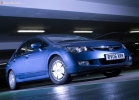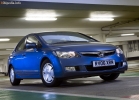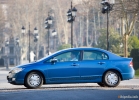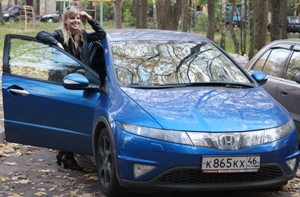Test drive Honda Civic sedan 2006 - 2008 sedan
"City athlete." Honda Civic car review
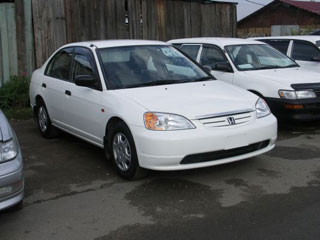 In the car market, finding Honda Civic will not be problems: there are both sedans and 5-door hatchbacks. But these models differ not only in the type of body, but also in costs. So, hatchback is not easy to find cheaper than $ 10,000, but for $ 11,000, a five -year -old car can easily find a new owner. Most likely, this is a fee for not the most common body in Japan and a fairly large scope in the cabin. Civic Ferio sedans are cheaper: on average, the cost starts at $ 7500. But this relative cheapness is explained by the complete set of the machine, in which there will be only the most necessary (but there is no tachometer, additional adjustments to the driver's seat, trunk upholstery, steel wheels will be covered with caps, etc.). If you want more, you will have to cook at least $ 9,000. However, this is still cheaper than a hatchback.
In the car market, finding Honda Civic will not be problems: there are both sedans and 5-door hatchbacks. But these models differ not only in the type of body, but also in costs. So, hatchback is not easy to find cheaper than $ 10,000, but for $ 11,000, a five -year -old car can easily find a new owner. Most likely, this is a fee for not the most common body in Japan and a fairly large scope in the cabin. Civic Ferio sedans are cheaper: on average, the cost starts at $ 7500. But this relative cheapness is explained by the complete set of the machine, in which there will be only the most necessary (but there is no tachometer, additional adjustments to the driver's seat, trunk upholstery, steel wheels will be covered with caps, etc.). If you want more, you will have to cook at least $ 9,000. However, this is still cheaper than a hatchback. Civic Ferio is very much reminiscent of a previous generation car, which may not like new lovers, but probably it will like conservatives
Once from Japan, almost everything that had wheels had and could move independently from Japan. Then there was a natural selection of the most reliable, comfortable and, importantly, repairing models. Since all Honda models were distinguished by a particularly high production and technological culture, naturally, for some time the popularity of this brand has significantly decreased. But today, the prestige of Honda is more than ever, and these cars buy very, very willingly. At the same time, more and more cars of the last generation are found. This is precisely this include Honda Civic.
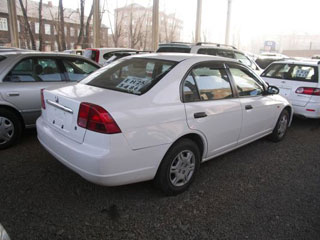 The front panel of the sedan, like the body, is very similar to that of the sixth generation of the model. Its most unusual detail vertically located a chiclima control
The front panel of the sedan, like the body, is very similar to that of the sixth generation of the model. Its most unusual detail vertically located a chiclima control Sales of the seventh (now the penultimate) generation Honda Civic, which will be discussed today, began in Japan in September 2000 and continued until August last year. Four types of bodies were offered for the domestic market: sedan (Civic Ferio), coupes, as well as five and three -door hatchbacks (the latter was represented in the mainly charged version of Type R). A distinctive feature of this generation of the model was the increasing height of the body: the increase in height near the sedan is 5, and the hatchback 10.5 cm! Naturally, this in the most favorable way affected the internal space and comfort: if desired in the hatchback, you can even try to get out of the front armchairs back (and vice versa), without leaving the car, since there is nothing between the seats: the automatic transmission is located on the console, A parking brake lever is replaced by a foot pedal. In addition, the hatchback is distinguished by a special ergonomics of the driver’s place: here you can located almost like in a home chair, all controls will be available and convenient. The sedan salon does not have internal movements, but here passengers will not feel constrained. Moreover, in both versions, the floor in the cabin does not have a tunnel.
1.5-liter D15B on sedans in the simplest configuration does not have a VTEC system
Regarding the space for the rear passengers, the sedan is not much superior to its classmates. Its chip of the absence of a tunnel on the floor
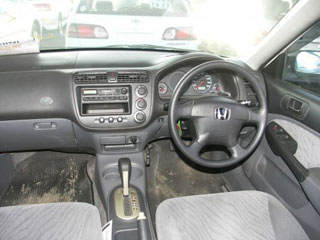 The simplest versions of the sedans have a very unpretentious trunk: there are no pockets, no hooks, or even upholstery in it, not to mention the possibility of folding the back of the rear sofa ...
The simplest versions of the sedans have a very unpretentious trunk: there are no pockets, no hooks, or even upholstery in it, not to mention the possibility of folding the back of the rear sofa ... As for the appearance of the penultimate civic, it is difficult to say something bad here. The hatchback is almost completely devoid of family features, but is distinguished by enviable elegance, which spoils of which is perhaps a slurred design of the stern. The Civic Ferio sedan, on the contrary, is very similar to the previous generation model of the same name: the main differences are reduced to the design and form of optics. There is similarity in the interior. However, by the end of the release of the sedans, a small facelifting passed, which in style brought them closer to the hatchback. However, the design of a car, whose age is more than six years, is a very, very conditional concept. The main thing in such cars is the technical condition, resource and reliability of the main nodes and assemblies.
Three engines for the seventh sivik are offered: 1.5-liter D15B (with the VTEC and without system), 1.7-liter D17A (VTEC) and for the Type R version of the 2,0-liter 215-horsepower K20A. Also, since the fall of 2002, a hybrid version of the model with a 1.3-liter 85-horsepower engine and a 134-horsepower electric motor was proposed. But in Irkutsk there are still such cars (as, indeed, Civic Type R) practically do not meet, therefore there is nothing to say about them. But as for ordinary sedans and hatchbacks Civic, there is already
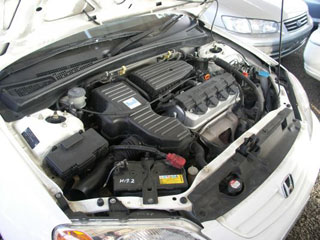 certain observations. Firstly, Civic engines belong to the so-called disposable, that is, not involving major repairs: only replacing the piston rings and liners with new ones are possible. In extreme cases, you can always choose a new engine from the contract of contract, which will serve no less than the first (taking into account the run in Japan, of course), since the cost of such engines is not much more than 20,000 rubles. Secondly, the Honda engines are distinguished by a special engineering and assembly culture, thanks to which the real engine resource is at least 200,000, or even more than 300,000 km. Even such banality as failure of all kinds of sensors of Honda Civic owners, as a rule, do not bother. But the quality of lubricants should be treated with special attention, especially car owners with a system of changed gas distribution phases (VTEC): the main thing here is not to use excessively fluid or, conversely, too thick oils. And, of course, to change them and filters in time (oil, fuel, air). In general, the main condition for the long and reliable operation of the Honda engines is clean: the fuel system, the lubrication and cooling system, as well as combustion chambers. In addition, among the operational features of Honda engines in general and Civic, in particular, it is necessary to note problems with the cold winter launch of machines, the engines of which have a system for reducing the emission of exhaust gases LEV. Because of this system, as well as due to the differences between Russian gasoline from Japanese (we have less light fractions), the Levovo engines starting program are simply not able to provide guaranteed launching the motor at low temperatures. Previously, in Irkutsk, this problem was solved by installing a special device artificially increasing the supply of fuel during launch. But now experts
certain observations. Firstly, Civic engines belong to the so-called disposable, that is, not involving major repairs: only replacing the piston rings and liners with new ones are possible. In extreme cases, you can always choose a new engine from the contract of contract, which will serve no less than the first (taking into account the run in Japan, of course), since the cost of such engines is not much more than 20,000 rubles. Secondly, the Honda engines are distinguished by a special engineering and assembly culture, thanks to which the real engine resource is at least 200,000, or even more than 300,000 km. Even such banality as failure of all kinds of sensors of Honda Civic owners, as a rule, do not bother. But the quality of lubricants should be treated with special attention, especially car owners with a system of changed gas distribution phases (VTEC): the main thing here is not to use excessively fluid or, conversely, too thick oils. And, of course, to change them and filters in time (oil, fuel, air). In general, the main condition for the long and reliable operation of the Honda engines is clean: the fuel system, the lubrication and cooling system, as well as combustion chambers. In addition, among the operational features of Honda engines in general and Civic, in particular, it is necessary to note problems with the cold winter launch of machines, the engines of which have a system for reducing the emission of exhaust gases LEV. Because of this system, as well as due to the differences between Russian gasoline from Japanese (we have less light fractions), the Levovo engines starting program are simply not able to provide guaranteed launching the motor at low temperatures. Previously, in Irkutsk, this problem was solved by installing a special device artificially increasing the supply of fuel during launch. But now experts 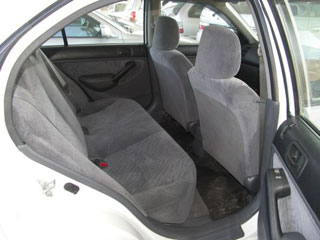 it is recommended that you simply run the engine from the second or third times (do two or three short scrolls of the starter) or not to torment the engines at all by installing the pre-heater. But using systems with auto -launch and warm -up of the motor is not recommended: poorly warmed engines at idle are prone to hair storage.
it is recommended that you simply run the engine from the second or third times (do two or three short scrolls of the starter) or not to torment the engines at all by installing the pre-heater. But using systems with auto -launch and warm -up of the motor is not recommended: poorly warmed engines at idle are prone to hair storage. It is unlikely that an additional shelf justifies a small volume of the glove compartment
There are no complaints about the reliability of Civic transmission elements: automatic machines and mechanics serve for a long time and even some carelessness in circulation allow. The main condition for their reliability timely replacement of oils or ATF (the Honda Z1 special liquid is prescribed for automatic transmission, however, according to experts, they are permissible to replace them with Castrol Transmax-Z or even ordinary, but high-quality and, as a more modern Dexron). But as for the variator gearboxes, there are problems that of which the most common (at least 60% of all cases) malfunction/wear of the friction unit that provides touching (Start-Clutch). This unit, in fact, is an automatic clutch that works with the released brake pedal and pressing the gas pedal. Symptoms of Start-Clutch malfunctions are manifested in a fuzzy start (possibly with a sharp impetus or even a blow), tightening the start process or trembling and twitching of the car when stopping. Fortunately, all these symptoms can be easily detected when choosing a machine. In extreme cases, replacing Start-Clutch assembly will cost about $ 250-300, replacing 12,000-15,000 rubles. But the exploring of the variator node (belt and driven/leading pulleys) in our conditions is practically incurable, since Honda does not supply this knot to replace. Even alternative manufacturers are unlikely to help here. The way out is actually one: replacement CV
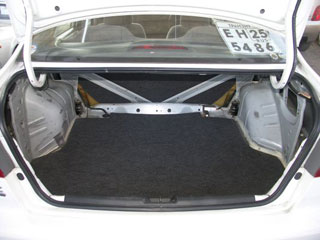 T, which can cost up to $ 2500, and it is not yet a fact that the new variator will really be in good condition. In addition, it is quite difficult to find this problem yourself (especially those who have not encountered the variators before). It remains only to be consoled by the fact that, firstly, the initial resource of variators is actually equal to the motor resource (of course, if the Japanese owner served the car on time and efficiently), and secondly, this problem is less common. But besides the Start-Clutch and the variator node, the CVT Honda Civic can be attributed to the malfunctions of the actual mechanisms (solenoids), as well as the general clogging of the variator. The cleanliness in the cavity of the box, by the way, also affects the serviceability of Start-Clutch. So the main requirement for the owners of civic (especially variator) purity in nodes and assemblies. By the way, the manufacturer prescribes to use exclusively Honda Multi Matic Fluid in variators, in extreme cases Honda Z1, but nothing else!
T, which can cost up to $ 2500, and it is not yet a fact that the new variator will really be in good condition. In addition, it is quite difficult to find this problem yourself (especially those who have not encountered the variators before). It remains only to be consoled by the fact that, firstly, the initial resource of variators is actually equal to the motor resource (of course, if the Japanese owner served the car on time and efficiently), and secondly, this problem is less common. But besides the Start-Clutch and the variator node, the CVT Honda Civic can be attributed to the malfunctions of the actual mechanisms (solenoids), as well as the general clogging of the variator. The cleanliness in the cavity of the box, by the way, also affects the serviceability of Start-Clutch. So the main requirement for the owners of civic (especially variator) purity in nodes and assemblies. By the way, the manufacturer prescribes to use exclusively Honda Multi Matic Fluid in variators, in extreme cases Honda Z1, but nothing else! Thanks to the completely flat floor, the absent levers of the Communist Party and the handbrake, as well as the folding armrest, the hatchback passengers can, without leaving the car, move along the cabin. True, provided that their growth is below the average ...
The hatchback, unlike the sedan, offers more living space both in front and behind
Many Civic have an all -wheel drive transmission with a DPS (Dual Pump System) by the Honda, traditional for Honda). When choosing such a car, it is necessary to check its serviceability (DPS is triggered when the front wheels are slipped or when the angular speeds are, for example, in steep turns) and keep in mind that the DPS resource is actually about 1,50,000 km, and then it is lucky.
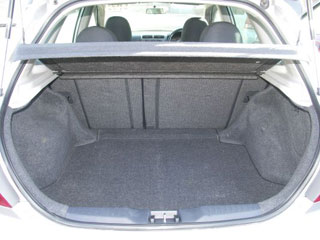 D15b on hatchbacks is most often characterized by the presence of variable phases of gas distribution. But here VTEC is configured to achieve maximum torque in the widest engine speed, and not for maximum power, as before
D15b on hatchbacks is most often characterized by the presence of variable phases of gas distribution. But here VTEC is configured to achieve maximum torque in the widest engine speed, and not for maximum power, as before Hatchback trunk is modest, but neat
The seventh -generation suspension Civic, as already mentioned, is made almost according to the classical scheme: McPherson depreciation racks with a subframe in front and completely independent, with amortization racks, back. At the same time, the reliability of the Civic chassis is one of the exemplary in the classroom. As such, there are no weak places in the seventh generation suspension. Pay attention to only the silent blocks (especially the rear). And, of course, shock absorbers are out of order on our roads faster than usual.
Summarizing all of the above, it can be noted that the seventh Civic is a solid, modern and very reliable car, among the advantages of which there is good handling, efficiency and spacious salon. The disadvantages, of course, are also (they have not yet created cars without them), but not one of them should be attributed to those that could serve as recommendations to the refusal of the acquisition of Civic. Even variator boxes cannot be called a frankly weak link in the car: the main thing is not to buy a dhatted and hackneyed copy. However, the features of the purchase of a used car are a completely different topic ...
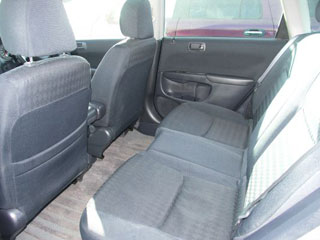
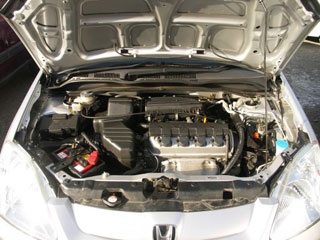
Alexey Stepanov
Automarket magazine + sport
Source: Drom.ru
Honda Civic Crash Test Video Sedan 2006 - 2008
Honda Civic Sedan 2006 test drives - 2008
Honda Civic Crash Test Sedan 2006 - 2008
Krassh Test: Detailed Information31%
Driver and passengers
21%
Pedestrians
38%
Children-passengers

